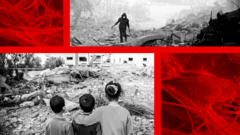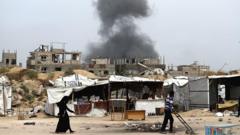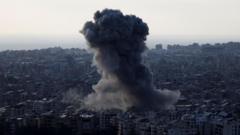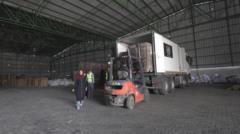With an estimated 2.3 million tons of potentially asbestos-infested debris in Gaza from military attacks, experts emphasize the long-term health hazards, including a silent rise in lung diseases and cancers among the population, particularly children.
Toxic Legacy: Asbestos Threat from Gaza's Rubble

Toxic Legacy: Asbestos Threat from Gaza's Rubble
As the aftermath of ongoing conflict in Gaza unfolds, experts warn of the severe risk posed by asbestos contamination amidst the rubble.
As Israel's military campaign in Gaza continues to devastate the region, experts are raising alarms about a hidden danger lurking amidst the rubble: asbestos. The once-common building material, now notorious for its health risks, releases toxic fibers when disturbed, posing serious threats to those nearby.
The United Nations Environment Programme (UNEP) reports that asbestos, especially in roofing materials, is prevalent in Gaza's urban refugee camps dating back to the 1948-49 Arab-Israeli war. As of October 2024, UNEP estimates that up to 2.3 million tons of rubble, likely contaminated with asbestos fibers, will be removed from the area.
Professor Bill Cookson, director of the National Centre for Mesothelioma Research in London, describes the environment created by the rubble as "very, very toxic," with long-lasting consequences that may follow affected children into adulthood. "The lives lost now are not going to end here. The legacy is going to continue," adds Liz Darlison, CEO of Mesothelioma UK.
When asbestos is disturbed, its fibers become airborne, presenting risks of inhalation. Even minimal exposure can lead to severe health issues, including asbestosis and mesothelioma—a formidable lung cancer that typically manifests 20 to 60 years post-exposure.
Gaza's densely populated conditions make avoiding asbestos inhalation exceptionally challenging. Dr. Ryan Hoy points out that the intricate web of tiny asbestos particles can deeply infiltrate the lungs, especially in locations where the air is saturated with dust.
On the ground, health professionals assert that immediate threats from military operations overshadow concerns regarding asbestos. Chiara Lodi, medical coordinator for Medical Aid for Palestinians, highlights that in such dire conditions, locals are preoccupied with survival and often unaware of asbestos risks.
Echoes of similar situations from past conflicts, such as in 2009 when previous hostilities exposed people to asbestos in debris, warn against neglecting this threat. Asbestos types vary in danger level, from low-risk "white asbestos" to the harmful "blue asbestos," which has already been identified in Gaza.
The global response to asbestos has been a mix of caution and regulation, with approximately 68 nations banning its use. As reconstruction plans emerge following the fallout of recent violence, effective management of asbestos-laden rubble will be crucial. UNEP warns that necessary clearing efforts could stretch over two decades, costing as much as $1.2 billion.
In light of the catastrophic death toll from conflict, UN assessments predict that ongoing exposure to toxic dust and debris could lead to illnesses that surpass fatalities inflicted directly by military violence. As alerts grow louder over this looming public health crisis, strategies to safeguard the health of Gaza's beleaguered populace are paramount.

















